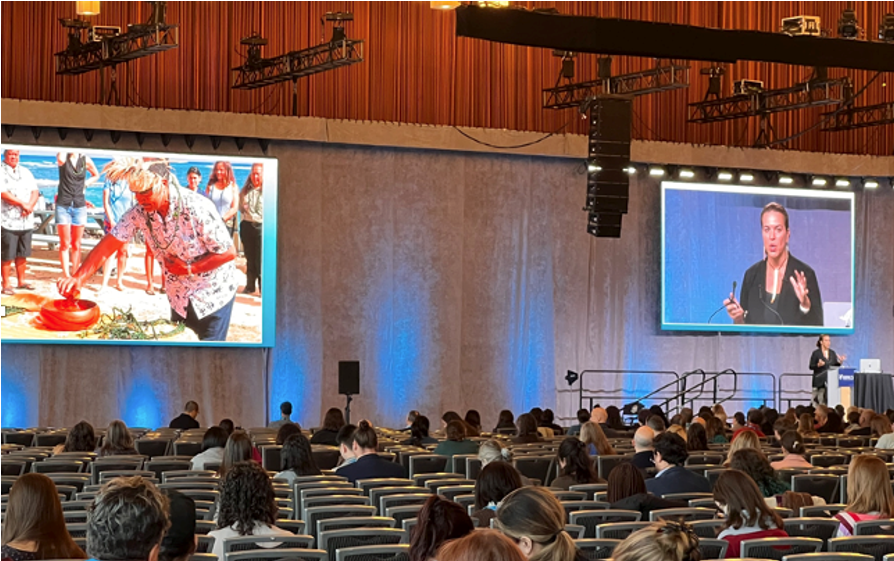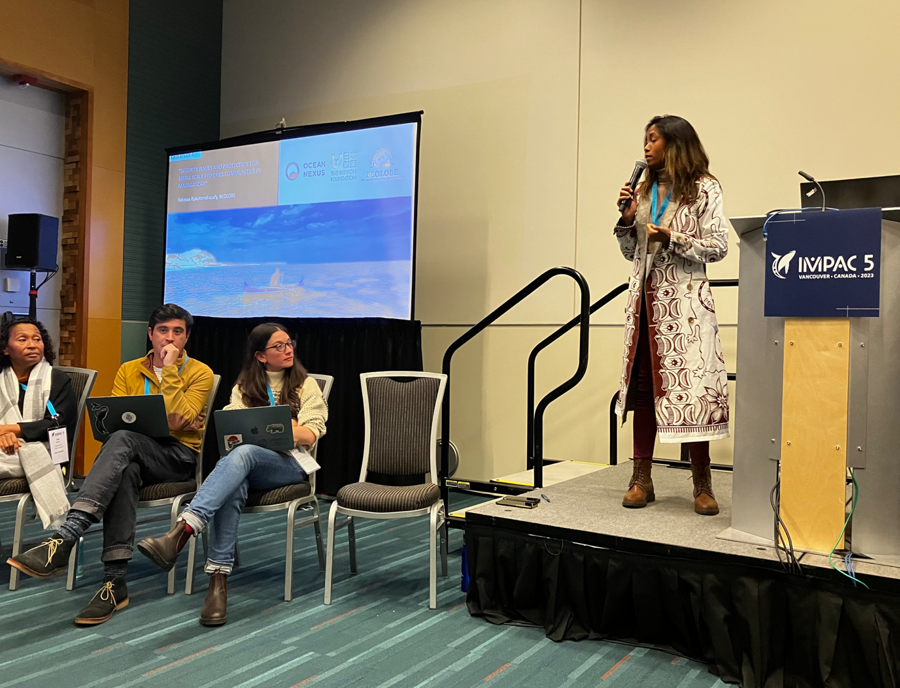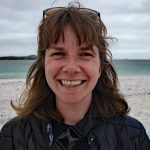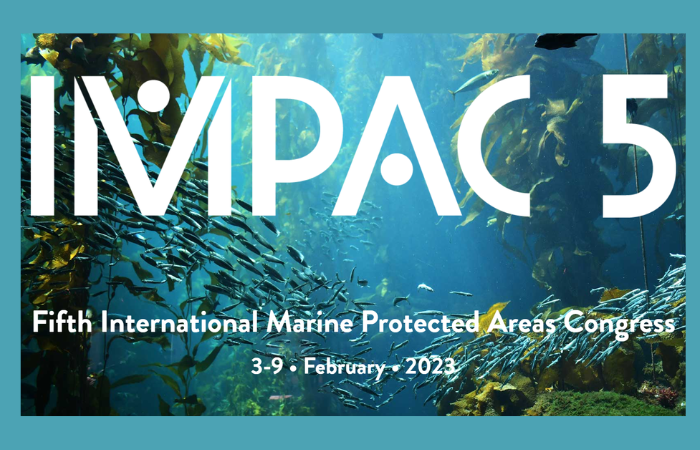Text by Mika Schröder and Cathy Li
The 5th International Marine Protected Area Congress (IMPAC5) wrapped up last March in Vancouver, Canada, on the traditional territories of the host First Nations – xʷməθkʷəy̓əm (Musqueam), Sḵwx̱wú7mesh (Squamish), and səlilwətaɬ (Tsleil-Waututh) – following days full of inspiring and thoughtful discussions. While significant progress was made, especially regarding the recognition of Indigenous Peoples’ central role in marine stewardship, the authors still feel that more could have been done to highlight broader issues of justice, including gender equity. This blog post offers some insights into what was said about gender, equity and justice at the Congress. It offers a few reflections on how we can ensure greater (re)focused attention on these topics in upcoming work on marine stewardship.
Taking stock – the good and the lacking
Reflecting back on IMPAC5, there was a lot that was inspiring and encouraging about Congress. To name a few, the incredible line-up of keynote speakers was like a breath of fresh air, bringing to the fore issues of colonial/parachute science, rebuilding and healing community connections with customs, threatened languages and the Ocean. Speakers held space for the trauma of colonial violence, while also speaking of hope through reconciliation. Participants were regularly reminded of the importance of Indigenous rights to their territories, self-governance and sovereignty, as well as the importance of recognizing and centering diverse worldviews and knowledge systems within marine conservation. Sessions under the workstreams on Indigenous Peoples’ leadership and young professionals often facilitated discussions intersecting with topics important to Women4Biodiversity and the Women’s Caucus to the Convention on Biological Diversity (CBD), including issues of governance, rights, power dynamics, knowledge production and sharing, technological solutions, capacity sharing and so on.
Yet, gender equity, and the question of women’s empowerment and stewardship more broadly, were not explicitly on the agenda, nor was justice. Of all the 250-something sessions advertised during the Congress, only one explicitly covered gender, while five sessions were on social justice and equity. This is not to say that these topics weren’t touched upon elsewhere (especially in the 111 sessions falling under the Indigenous Peoples Leadership stream), but still, it feels like a missed opportunity for IMPAC5 organizers to place questions of equity and justice (by looking at intersecting issues, including gender) front and centre in efforts to tackle the degradation of marine environments.

Photo credit: Nathan Bennett
Insights from IMPAC5
The IMPAC5 sessions looking at gender, equity and justice, highlighted a pressing need for these issues to be given greater focus. This is especially true in marine conservation given its repeated past offices of excluding and committing violence against Indigenous Peoples and local communities, including the exclusion of important community members, including women and youth voices.
For instance, during the event on gender, looking specifically at women in Madagascar’s small-scale fisheries, we heard that the establishment of marine protected areas has predominantly affected women fishers, pushing them onto more land-based activities. This was due to a number of factors, such as official documentation designating women’s fishing practices, which predominantly took place on foot, as “unprofessional”, while “real fishing” was that carried out by men from boats. The research team, led by Dr Mez Baker-Médard, also found that women’s inclusion was low in both fishing activities as well as within decision-making processes, where women typically only made up 1-15% of participants. The session also highlighted grassroots organizing directed at gender-inclusive networks for increasing solidarity and celebrating women’s leadership. We heard from Vatosoa Rakotondrazafy and Marianne Randriamihaja on their work promoting fishers’ rights, including setting up a dedicated Fisherwomen Leadership Program to specifically tackle the underrepresentation of women within the fisheries sectors. They both made the point that targeted action for enhancing women’s leadership would lead to further normalization of women in decision-making processes more broadly.

Photo credit: Nathan Bennett
Equally insightful was the event on social equity in marine conservation. Here, participants began by considering justice-related issues they felt were absent at IMPAC5. The list was long but included gender and women’s leadership, racism, language and cost barriers, visa restrictions and challenges facing immigrant youth. Many felt that there hadn’t been enough emphasis on equity and justice concerns being important throughout all stages of marine conservation – from the collection and creation of information and data to the selection of sites, to ask who is included/excluded from decision-making and the elaboration of policies, and ensuring that diverse values (beyond economic- and ecological-framings) are incorporated into processes.
We were reminded that even focusing solely on rights-based approaches isn’t straightforward, in part because not everyone has the privilege of relying on their government institutions for their safeguarding, or because rights-framing doesn’t always align with worldviews which emphasize responsibility over ownership/entitlements. For example, one participant pointed out that Sustainable Development Goal 14 on “life underwater” ignores connections between seas, lands and skies, reminding us of the importance of considering how issues are framed, and how these may sometimes risk reinforcing outdated logic on peoples’ separation from nature, and thus implicitly excludes concerns of local communities.
So, where to next? Reflecting on leverage points
Important steps were taken at IMPAC5, especially for ensuring greater recognition and solidarity for Indigenous-led marine conservation. However, that’s not to say that more work isn’t still needed to bring equity and justice into these spaces, and for that to be informed by intersecting interests and perspectives, including women’s voices.
Throughout IMPAC5, we were constantly reminded (predominantly by government representatives) of the 30 x 30 target, adopted under the Kunming-Montreal Global Biodiversity Framework, which applies equally to coastal and high seas spaces. Yet, we also know that historically, establishing marine protected areas has marginalized, displaced and socially impacted local communities, small-scale fishers, and Indigenous populations. These issues are then further compounded by gender-based violence and exclusion in activities, decision-making and knowledge production. So there is a greater need to assess the “how” of the 30 x 30 target (and marine conservation more broadly), with several of the other targets, including Target 22 on full, equitable, inclusive and effective participation, and Target 23 on gender-responsive approaches, offering guiding lights for its implementation. Judging by discussions at IMPAC5, it is clear that partners within the marine conservation movement will need reminding that the targets must be implemented in a holistic manner, with Target 22, 23 and others informing the 30 x 30 target.
An important lesson from Congress was the need to continue creating and building stronger connections and networks for supporting grassroots actions, including greater attention shown to the barriers that women and partners experience in bringing questions of equity, justice and gender, within marine conservation debates. Work at the CBD negotiations provides a key arena for this, especially in the upcoming efforts on the development of a robust monitoring framework, where the elaboration of indicators for assessing participation, governance, financing, access to information and justice, will be absolutely imperative.
Another potential avenue for ensuring greater attention and support for women’s voices is International Union for Conservation of Nature (IUCN) funding. While it’s great to see IUCN highlighting youth and Indigenous Peoples’ engagement and leadership in its events, it’s unfortunate that not the same attention is given to women’s leadership. For example, IMPAC5 dedicated various events and financial resources for youth and Indigenous Peoples, similar to various past headline IUCN events, including the 2021 World Conservation Congresses. Again, at the 2021 World Conservation Congress, we witnessed limited attention in highlighting the gender lens of nature conservation beyond that of keeping a gender balance among speakers. We would therefore like to encourage IUCN to dedicate more resources and attention to supporting gender activists’ participation in its events, as well as to highlight their expertise and leadership
About the authors

Mika Schröder is a researcher with a background in law and social justice. The main focus of her work concerns the interrogation and reimagining of global conservation endeavours by accommodating and embracing local perspectives and experiences. This includes exploring avenues for the recognition and safeguarding of community rights, knowledge and perspectives within international environmental law and governance.

Cathy Yitong Li has been following UN climate processes from gender and youth perspectives since she was a teenager. Cathy is a facilitative committee member of the UN Framework Convention on Climate Change’s (UNFCCC) Women and Gender Constituency, and a steering committee member of the IUCN Climate Crisis Commission.

